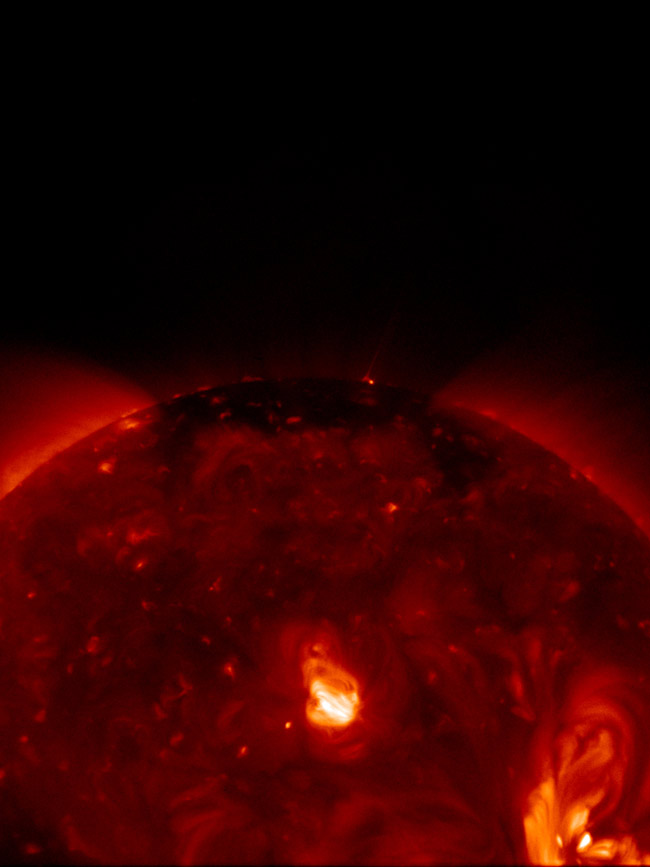Sun's Magnetic Secret Revealed

Powerfulmagnetic waves have been confirmed for the first time as major players in theprocess that makes the sun's atmosphere strangely hundreds of times hotter thanits already superhot surface.
Themagnetic waves — called Alfven waves — can carry enough energy from the sun'sactive surface to heat its atmosphere, or corona.
"Thesurface and corona are chock full of these things, and they're veryenergetic," said Bart de Pontieu, a physicist at the Lockheed Martin Solarand Astrophysics Laboratory in California.
The suncontains powerful heating and magnetic forces which drive the temperature totens of thousands of degrees at the surface — yet the quieter corona wreathingthe sun reaches temperatures of millions of degrees. Scientists have speculatedthat Alfven waves act as energyconveyor belts to heat the sun?s atmosphere, but lacked the observationalevidence to prove their theories.
De Pontieuand his colleagues changed that by using the Japanese orbiting solarobservatory Hinode to peerat the region sandwiched between the sun's surface and corona, called the chromosphere.Not only did they spot many Alfvenwaves, but they also estimated the waves carried more than enough energy tosustain the corona's temperatures as well as to power the solar wind (chargedparticles that constantly stream out from the sun) to speeds of nearly 1 millionmph.
However,the chromosphere findings alone could not prove the waves carried their energyinto the sun?s atmosphere.
?If youobserve waves in the chromosphere, that doesn?t mean they can get to thecorona,? De Pontieu told SPACE.com.
Get the Space.com Newsletter
Breaking space news, the latest updates on rocket launches, skywatching events and more!
Some wavesmay get reflected back down to the sun instead of passing through thetransition region between the surface and atmosphere. Waves that reach thecorona also become more difficult to detect using current instruments, thanksto the long line-of-sight.
De Pontieu?sgroup turned to researchers at the University of Oslo, Norway, who had createda computersimulation representing part of the sun. Once they knew what to look for,the researchers found magnetic waves within the simulation of the corona thatstrongly resembled the Alfven waves directly observed in the chromosphere.
Even as thesimulations helped establish Alfven waves as energy carriers for the sun?satmosphere and solar wind, the new observational findings will help modelerscreate improved sun simulations.
?It goesback and forth — we learn from simulations, they learn from us,? said DePontieu.
Manymysteries remain about the sun?s restless activities. De Pontieu?s groupfocused on Alfven waves generated by the sun?s heat turbulence, but otherresearchers examined Alfven waves generated when the sun?s magnetic field linesstress and snap back together like invisible magnets. That reconnection forcealso creates jets of X-rays that shoot outwards from the sun, as captured by Hinode?sinstruments.
Scientistsstill don?t know which source of Alfven waves plays a more important role inthe heating the sun?s atmosphere, but can use the latest findings as a steppingstone.
?We need tostudy both more, to see which one dominates,? noted De Pontieu. ?But it?s nicefor people to know that Alfven waves can do the job.?
- VIDEO: Solar B Hinode: Coronal Questions
- IMAGES: Solar Flares
- IMAGES: Sun in a New Light
Join our Space Forums to keep talking space on the latest missions, night sky and more! And if you have a news tip, correction or comment, let us know at: community@space.com.
Jeremy Hsu is science writer based in New York City whose work has appeared in Scientific American, Discovery Magazine, Backchannel, Wired.com and IEEE Spectrum, among others. He joined the Space.com and Live Science teams in 2010 as a Senior Writer and is currently the Editor-in-Chief of Indicate Media. Jeremy studied history and sociology of science at the University of Pennsylvania, and earned a master's degree in journalism from the NYU Science, Health and Environmental Reporting Program. You can find Jeremy's latest project on Twitter.









